
The team sitting around the table at Groupon’s Chicago headquarters in the early spring of 2011 were some of the brightest minds in technology and business. Marc Andreessen, the man who created the modern web browser and Silicon Valley’s hottest venture capitalist. Mary Meeker, Wall Street’s internet oracle. Howard Schultz, the chairman and CEO of Starbucks. And of course, the team from Groupon: the precocious chief executive Andrew Mason, its hard-driving chairman Eric Lefkofsky, and its European czar, Oliver Samwer.
At issue was whether or not the company should file to go public. Andreessen, Meeker, and Schultz recommended against it. The company still needed to mature, to perfect its core offerings. The mantra at Groupon was that it was building the operating system for local commerce, but the technology at that point, according to sources*, was still largely aspirational. Groupon's developers and engineers were too busy putting out fires to build out a great platform. What was really driving the company forward was its ever-growing sales force, which had a total headcount of 126 at the start of 2010 but had grown to over 5,000 by April of 2011.
Mason was on the fence. He wanted Groupon to be a big success, and styled himself as a product visionary, a young Jeff Bezos. But he also wanted to protect the quirky culture he had built at the company and retain the independence that was the hallmark of his character.

Andrew Mason and Erik Lefkofsky after the Groupon IPO, Nov. 2011. Credit: Justin Lane / European Pressphoto Agency.
Lefkofsky and Samwer, on the other hand, were adamant. "They wanted this rocket ship to take off and nothing was going to stop them," said a source who attended the meeting. Together, along with Lefkofsky’s longtime partner Brad Keywell, those in favor of an IPO controlled over 40 percent of the company and a larger percentage of the voting rights. Against the warnings of the brain trust they had recruited to advise them Lefkofsky and his allies decided to push on. "It doesn’t matter who is sitting across from him," said a source who worked closely with Lefkofsky for years. "As far as Eric is concerned, he is always the smartest fucking person in the room."
Groupon went public in November of 2011, raising $700 million at a market capitalization of $12.5 billion. Judged by its revenues and valuation at that moment, it was the fastest-growing company in history. But as its board members had warned, it wasn’t ready for the spotlight. Its accounting came under fire from the SEC. It was sued by investors and employees. The company repeatedly missed Wall Street expectations and reported increasingly large losses. Its stock at this point has dropped over 80 percent since the IPO.
"They wanted this rocket ship to take off and nothing was going to stop them."
After it missed its marks again last week, Lefkofsky and the board forced Mason to step down, and began the search for a new chief executive. Whoever that person is will have before them a giant crisis and tremendous opportunity: Groupon’s business is on pace to do more than $6 billion in global bookings this year, and it’s still the leader in terms of sales and customers in the daily deals industry it helped create. But it’s also struggling to find a profit, its margins are shrinking, and most importantly, its reputation has been badly damaged, making it tough to attract top talent. Groupon needs a makeover, even if it has to pay full price.
The biggest obstacle to this kind of transformation, according to half a dozen current and former employees who worked with him, is Eric Lefkofsky. In Frank Sennett’s terrific book, Groupon’s Biggest Deal Ever, Mason recalled that his nickname for Lefkofsky was Punchable. "He seemed like a guy I wanted to punch, because he’s so insensitive to creating any kind of decorum or comfort for anybody."
"That’s so true," Lefkofsky replied. "I’m not warm and fuzzy."
The reality, according to several sources, is a bit darker than his disposition. "The truth is, Eric is a brilliant guy," said a former executive who worked closely with Lefkofsky at Groupon. "But his greed overwhelms his intelligence. It drives him to make short term decisions, always in the pursuit of bigger, more, now. And he does not mind if other people get burnt along the way."
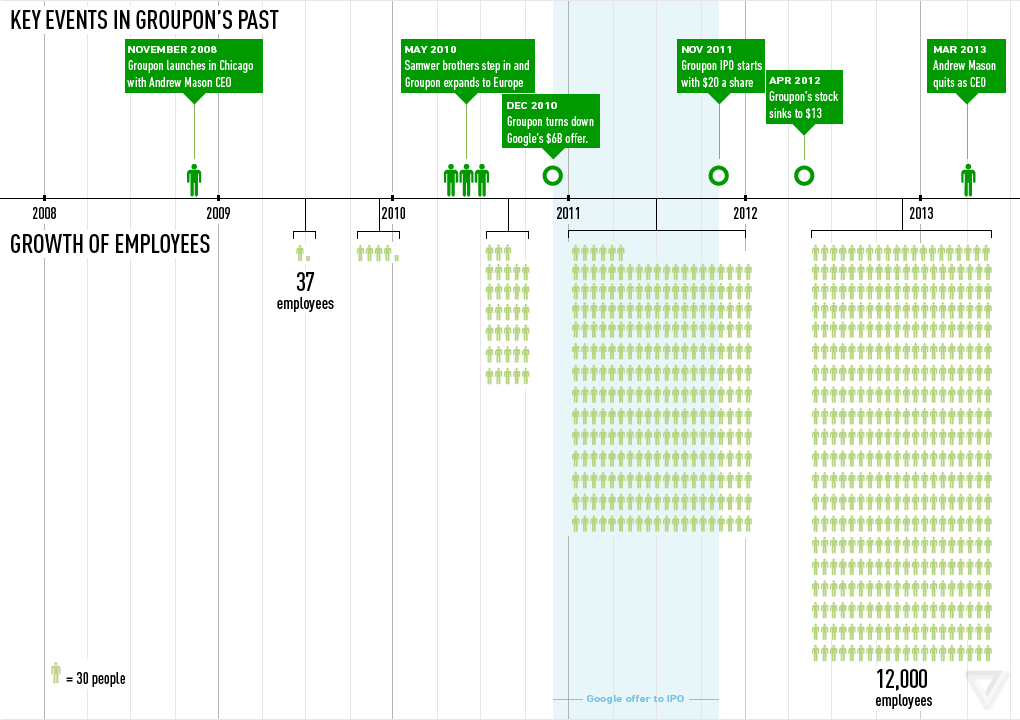
The Samwer brothers
Let’s rewind the tape about one year before that fateful board meeting. Groupon made its first major European acquisition in May of 2010, buying the Berlin-based CityDeal (the most successful Groupon copycat) from the infamous Samwer brothers in exchange for a 10 percent ownership stake in Groupon.
The business model the Samwers built at their tech incubator Rocket Internet was simple: take a successful American startup and clone it for the European market. They sold Alando, their eBay clone, to eBay, for $43 million after just 100 days in business. They went on to create copies of Airbnb, Pinterest, and Groupon. The difference was that the Samwers' version had none of the free beer, ping pong tables, or relaxed working environments of their US counterparts. It was American ingenuity molded to fit ruthless German efficiency.
"When it comes to business, Lefkofsky has a reputation as a shark."
After the CityDeal purchase, Marc Samwer begun running Groupon’s overseas operations and expansion, and Oliver Samwer became close to Mason and Lefkofsky, helping guide the company’s hypergrowth. In a way, the trio were kindred spirits: blunt, aggressive and with no patience for bureaucracy. "When it comes to business, Lefkofsky has a reputation as a shark," said a source who worked closely with the pair. "If he’s a shark, the Samwer brothers are killer whales."
Groupon’s North American business had been growing rapidly, but the Samwers put that to shame. Their breakneck expansion mean that, by December of 2010, according to sources familiar with the company’s finances, overseas revenues had basically pulled even with North America. By the middle of 2011, overseas had passed North America in total revenues.
This success had two effects: it impressed Lefkofsky and Mason, who began to listen to the Germans as much, if not more, than their own executive team when it came to important decisions. But it also enraged Oliver Samwer, who felt that his ten percent ownership stake had been a raw deal, since his outfit was contributing so much to Groupon’s business. To get what he deserved, Samwer wanted to grow as big and as fast as possible, then cash out. This win-at-all costs race to the top aligned perfectly with Lefkofsky’s modus operandi.
Six months later, in December of 2010, he got his chance. The eyes of the world were on Groupon. From tech to finance, everyone wanted to know: will the quirky startup from the Windy City accept a $6 billion buyout offer and become Google’s biggest acquisition in history?
This was an outrageous offer for a company that had reported just $30 million in revenue for all of 2009, and any ordinary startup would have taken it. But Groupon’s growth in 2010 was off the charts, and bankers from Morgan Stanley and Goldman Sachs were salivating at the prospect of leading its public offering. Goldman chief Lloyd Blankfein made the trip to Chicago personally to woo Groupon. "The bankers broke out all these charts," said a source familiar with the meetings. "They showed Eric a growth matrix that projected Groupon would be worth $25 billion in a few years. When he saw that, Google was toast."
A deal with Google wasn’t a sure thing: it would be subject to antitrust scrutiny and could take up to a year to complete. Oliver Samwer was against it. A source who was present at the negotiations said there was no way Samwer was waiting a year for a deal that might get killed, a detail confirmed in Frank Sennett’s book. With visions of an IPO dancing in their heads, Lefkofsky and Samwer convinced Mason and the others that the company shouldn’t sell.

Oliver Samwer. Credit: Getty images.
And so Groupon charged ahead, across Europe and beyond. The Samwers took Lefkofsky’s emphasis on direct sales and call centers to its extreme. Groupon went from having no international sales force in March of 2010 to being in 18 countries by May, closing out the year with a presence in 35 different nations. But the rapid expansion came with a price. "I have never seen working conditions as bad as this at any tech company in my entire career," said a source who visited multiple parts of Groupon’s sprawling empire. "Call it a boiler room, call it a sweatshop, it was the exact opposite of what Mason had created in Chicago."
The Samwers would pick a malleable 20-something MBA, fly him or her into a new country, and spend whatever was necessary to become the market leader. In 2010 the global marketing budget for Groupon was $40 million. The Samwers spent that on Europe alone. "They refused to be accountable to the home office," said a source who worked closely with them, "or to ever take their foot off the gas."
A senior Groupon employee still with the company described the process simply. "Eric decided that this was an arms race. It was a land grab. We had to be in more countries with more salespeople than anyone else." The logic was that Groupon is more of a sales business than a technology company. The best moat it could erect against the competition, especially from copycats, was to become the dominant player in every market. "Hardly any of the growth was organic," the same source explained. "Nine times out of ten we bought a copycat company in the country we wanted to expand into. Then the Samwers brought in their management team to scale it out."
"Eric decided that this was an arms race. It was a land grab."
Lefkofsky and Mason fell under the Samwers' spell. While sources say both of Groupon’s co-founders were obsessed with every detail of the business and often micro-managed numerous low level projects, they largely entrusted the Samwers with the details of Groupon’s overseas growth. They even brought in German managers to crack the whip with the American sales force, a culture clash that sources say had a very negative impact on morale.
Groupon’s downward slide since it went public can be attributed in large part to the Samwers' influence. The brothers largely cashed out before the IPO and left shortly afterwards, ceding control of operations back to Chicago. But their legacy remains. The enormous expansion they led left behind a mess that is having a severe impact on the health of Groupon’s current business. European sales have been the biggest drag on growth and profits. It had to write down its investments in China. Rather than focusing on improving its technology, Groupon is still struggling to get its basic platform deployed across all its foreign markets. Because it was buying up companies, rather than scaling out its own technology overseas, Groupon was basically running on dozens of incompatible platforms. According to a source familiar with the overseas business, in many Samwer outposts, employees weren’t using Groupon’s platform at all; they were literally selling deals over the phone and sending the results back to Chicago in the form of spreadsheets.
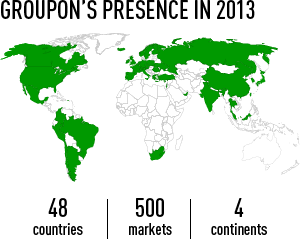
"I have never seen working conditions as bad as this at any tech company in my entire career."

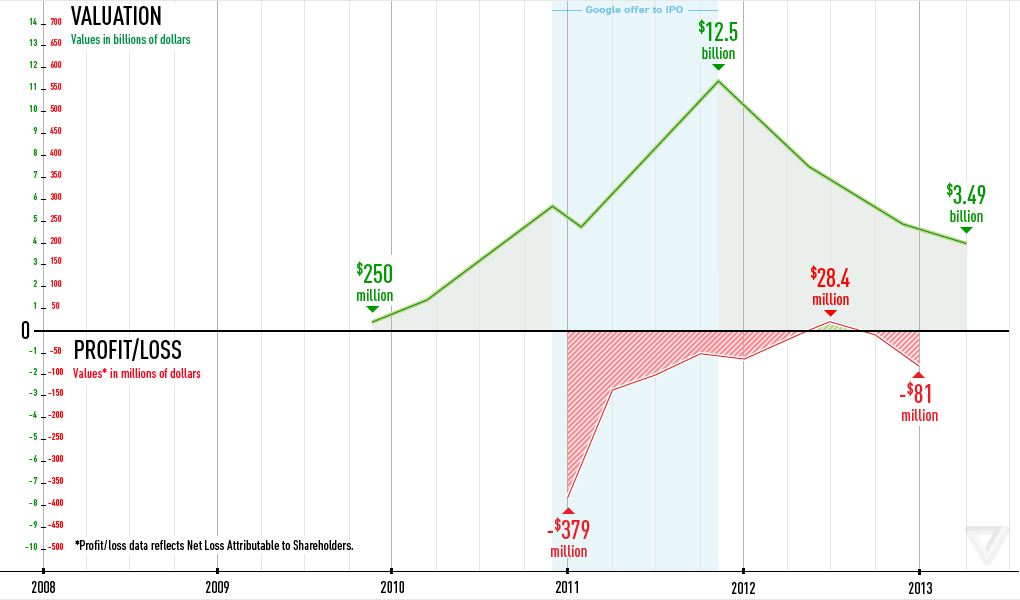
Profit/loss data reflects Net Loss Attributable to Shareholders. Source: Groupon
The aftermath
In the short six month period between rejecting the Google offer and going public, Groupon’s incredible growth continued... But since its IPO, everything has changed. After it began to submit its financials to public scrutiny, Groupon was forced by the SEC to change its accounting methods, and things have not been so rosy. Even with a new CEO, can Groupon be turned around?
As Andrew Mason recently wrote in a blog post explaining his departure. "I was fired today. If you’re wondering why… you haven’t been paying attention. From controversial metrics in our S1 to our material weakness to two quarters of missing our own expectations and a stock price that’s hovering around one quarter of our listing price, the events of the last year and a half speak for themselves."
Eric Lefkofsky declined to comment for this article. But we were able to reach his co-CEO, Ted Leonsis, a veteran AOL executive and Groupon board member who is taking over as temporary co-CEO, along with Lefkofsky, until a suitable replacement is found. "There is a ton of negative sentiment in the press about this company, and I think people don’t separate the signal from the noise," Leonsis told The Verge, "We have $1.2 billion in the bank. We have basically zero debt. And this last quarter, we had an operating profit. Yes, with one-time write downs, there was a loss. But the fundamentals of this business are sound."
Groupon is in the process of trying to transform from a growth company with a narrow focus on daily deals into a mature firm with a multi-faceted business. It has moved heavily into full priced e-commerce with Groupon Goods, putting it into competition with the likes of Amazon. And it’s investing heavily in technology like mobile payments and yield optimization algorithms at its R&D lab in Palo Alto. At the same time, however, companies like Google and Square are pushing into Groupon’s turf, working to capture the elusive crown as the "operating system" for small business, giving merchants ways to connect with local and repeat customers by offering deals through mobile apps.
"The fundamentals of this business are sound."
The stature of the new CEO will say a lot about the true health of the business. "If they can attract a real blue chip name, it will be a sign to Wall Street that there is still a lot of potential here," says Groupon chronicler Frank Sennett. "But whoever that person is, they better be prepared to work with Eric looking over their shoulder."
Lefkofsky has long remained in the background at Groupon, at least on paper. "He didn’t want any responsibility or accountability, at least not technically. But every single little decision had to be run by him," said a source who worked at the Chicago office. This was true for North America, although clearly less so overseas. "Whether that was an acquisition or a marketing campaign, he had a say. He would parachute in and be the CFO for a day, or the head of Corporate Development. He’s completely neurotic about every detail of the business."
The new CEO will have to work in Chicago, and sources say it will be tough to get a heavy hitter to move to Lefkofsky’s seat of power, far from the typical centers of tech and finance. They will have a massive clean-up job in Europe and beyond to deal with. To this day, present and former employees say, Groupon’s North American technology platform is still not deployed in much of Europe, Asia, and Latin America. And they will have to agree to run a company knowing that Lefkofsky still controls the largest stake and, along with his allies on the board, a clear majority of the voting shares.
Right now Lefkofsky has moved his desk onto the floor at Groupon’s Chicago office and is holding a series of all-hands meetings as he tries to whip the business back into shape. Why doesn’t he simply take over as CEO? "To Eric, that is a job, and he doesn’t work a job. In his mind, he is a visionary who manages CEOs," said a source who worked closely with Lefkofsky. Through his investment arm, Lightbank, Lefkofsky has funded a score of startups over the past few years. "As soon as one of those takes off, his focus will be there. There is nothing he relishes more than going on the roller coaster ride."
But how big and profitable can Groupon be? Prior to the IPO, Lefkofsky said the company was wildly profitable, a statement the SEC later forced him to retract. In the build-up to the public offering, numerous news stories floated a potential valuation of $25 billion, although it eventually debuted at $12.5 billion. Since then, however, the company has lost more than 80 percent of that value. While Groupon made billions for its early investors, it has destroyed far more, burning over $8 billion in wealth for its shareholders. Groupon’s peers, BuyWithMe and LivingSocial, have also struggled, despite having far less aggressive international expansion. The company’s harshest critics have floated the thesis that daily deals were just a facade, a hypergrowth machine, an internet bubble that could never be a stable, profitable business.
Even the company’s harshest critics, however, told The Verge that Groupon was no mirage. A former executive, who had heavily criticized Lefkofsky and the Samwers, said that he was astonished by people who opined that the daily deal industry was a charade. "This is a business that helps merchants to optimize their yield. It fills empty seats at a movie theater, empty tables at a new restaurant. The thing is, it’s not a new Google or Facebook, at least not yet. It’s not a pure tech play. It requires a lot of human sales, and so the margins are lower. Groupon could be a profitable business if it was managed well, but it might only be a five, six, or seven billion dollar company."
The history of Lefkofsky and Mason highlights the need for a new CEO who can stand up to his chairman. "I was talking with Andrew about his regrets," says Sennett, recalling a rare occasion where the rapid-fire Mason paused before speaking his mind. "He told me that he should have questioned the accounting metrics the company was using. But he relied on Lefkofsky to handle the finances. After the SEC began investigating this, I think he realized he should not have passed the buck."
Everyone The Verge spoke with who has worked directly with Mason says he’s not the clown that became his persona in the media. "He was an incredibly focused and hard-working guy," says Sennett. But in crafting his image as a goofball, Mason painted himself into a corner. "I don’t think Eric used Andrew, or that Andrew didn’t go in with his eyes wide open. But yes, the cynical interpretation is that Eric saw how useful Andrew could be, first as the charming, boyish entrepreneur, then as the fall guy for Groupon’s public plunge."
"Greed is good. Money is what matters."
Lefkofsky, who has a messy legal history founding hyper-growth companies that went belly up, earned the ill will of many Groupon employees when, well before the IPO, he took over $380 million of the company’s $1 billion final round of financing for himself. "It definitely soured a lot of folks, internally. But that is just Eric. He is completely unapologetic," says Sennett. "If he sees lightning in a bottle, he’s going to take it. If his investors will let him cash out, he will. There’s no point in asking why. Why does a dog lick his balls? Because he can."
His co-CEO, Leonsis, told The Verge this portrait of Lefkosfky is distorted. He points out that his last two companies, InnerWorkings and Echo Logistics, both went public and have remained profitable over time. Lefkofsky has not sold any of his still very substantial stake in Groupon since the IPO and repeatedly said he has no plans to. "People say Eric is short term, that makes me laugh," says Leonsis. "He’s holding his shares in Groupon for at least twenty five years, so I guess it depends on your definition of short term."
Others are less convinced. Nobody in the game knows how to take a business from zero to sixty quicker than Lefkofsky. But along the way, he often strips the gears. "To him, greed is good. Money is what matters. He will cross the line to get more," said a former Groupon executive. "His reputation, Groupon’s legacy, do not matter."
Asked if there were lines Lefkofsky would not cross, one source hedged his bets. Was Lefkofsky just the ultimate capitalist or something far worse? "I don’t know," they said. "Was Gordon Gekko a sociopath?"
A note on sourcing. For this story we spoke with a dozen current and former employees, executives, investors, and board members. Numerous sources would only speak on the condition of anonymity, often because they had to sign non-disclosure and non-disparagement agreements as part of their employment contract with Groupon. When this was the case, The Verge made sure to verify all claims with at least three separate sources before publishing. We also reached out to Groupon PR and Eric Lefkofsky, who declined to comment.
Disclosure: Ted Leonsis is an investor in Vox Media, the parent company of The Verge.
Russell Brandom contributed reporting to this story.
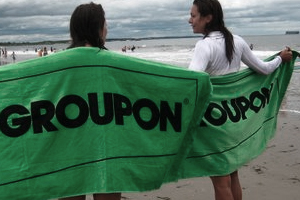
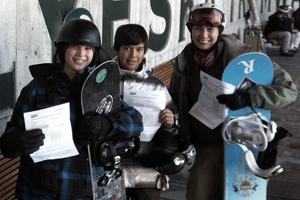
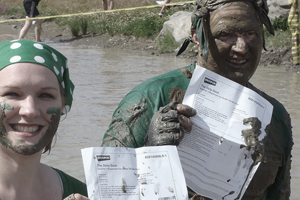
Loading comments...